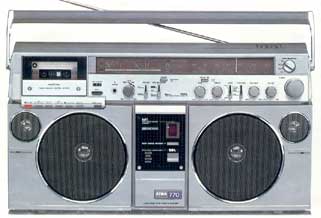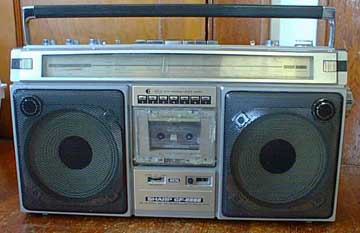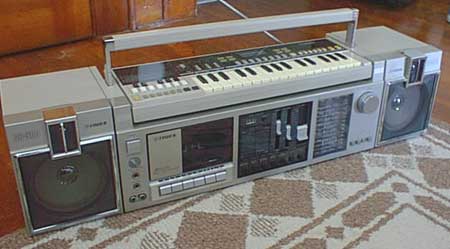Aiwa’s CS-770 was offered in 1981 and had the same high quality tape drive that the CS-880 had. It also featured D.S.L or Dynamic Sound Loudness, which enhanced low frequency sounds (now know as “bass boost” on current systems). The little digital display between the speakers is the random access system for the cassette drive.

Author Archives: pocketcalculatorshow
Ten Dollar Sharp GF-8686
We have a section on our website that shares cool, unusual electronic stuff we’ve found “in the wild” for a bargain. This Sharp GF-8686 would certainly fall into that category; we found this one at a flea market for $10 and it works perfectly! Those little silver button above the cassette door are part of the APLD, or the Auto Program Locate Device. This was a popular feature on the higher-end boomboxes, as was the was mic-mixing feature.

Toshiba RT-S893
Lloyd’s V330
The Lloyd’s V330 is one of the heaviest systems we have ever found. It’s over 30″ in length, and the detachable speakers are made with wood pressboard rather than plastic. There’s a nice little LCD clock and a little metal bracket underneath the cassette controls. You may notice the audio control knobs don’t quite match, but everything still works and sounds surprisingly good for a budget brand name.

Sony CFS-77
Sony didn’t sell the biggest or loudest boomboxes in the world, but they were well made and their sound was terrific. This CFS-77 was no exception–it was sold up to 1983 and had most unusual floating tweeters positioned in front of the speakers. Sony was of the opinion that “less is more,” evidenced in the sleak shapes of their walkmans and televisions. We see this in the narrow CFS-77, CFS-99 and CFS-500.

Fisher CR-300 Stereo Composer Boombox with Keyboard
Wow, what a cool system. Apparently, Casio wasn’t the only company to cross-breed a synthesizer and ghetto blaster. Fisher did also, and the result was this SC-300 Stereo Composer. This system is unusually long, but feature-packed. We’ve got detachable speakers, a vertical level meter, four band radio, auxilary input and of course, the cool synthesizer mounted up top! The user can play the keyboard and record directly to cassette. The keyboard’s got a cool little LCD display which displays the instrument that’s being played and the key that’s pressed.

Aiwa TPR-955
Aiwa’s TPR-955 was sold around 1980-1981, but it was ahead of its time. The digital LED counter provided instant access for up to 9 segments on a tape (separated by blank space) and doubled as a sleep timer. The cassette-eject mechanism was oil-damped, and the DM-511P option was a pair of microphones that mounted to the top of the portable for professional-sounding live stereo recordings.
Aiwa CS-880
Aiwa’s 1981 CS-880, a magical ghettoblaster that offered “3D” acoustic sound through a unique speaker arrangement. Aiwa’s tape decks have an impeccable reputation, the 880 and 770 for example offered a 0.038% wow and flutter: an impressive stat indeed for a portable stereo system. The awesome look and features make this one among the top for boomboxes.

1981 Buscom SoftTouch AutoDialer

What was the ultimate convenience in telephony back in the early ’80s? Touch-tone dialing, of course. In this period, many of us were still stuck on the rotary-dial telephones rented by the phone company. Sure, we made do, but what a luxury it would’ve been to have touch-tone dialing. Buscom made this ingenious little device called the Soft Touch AutoDialer. It replaced the phone’s plastic microphone screen by screwing into the talking end of the telephone receiver. Once it’s on, touch tone away! This gadget was powered by the current of the phone line and the model pictured above actually had the ability to store phone numbers! Program long numbers for those exotic new phone services like tele-banking and toll-free numbers. We grabbed the one pictured in an urban electronics shop. The original price tag said $179.95, we talked them down to five bucks.

1970s Lloyd’s Accumatic E613 Calculator and Alarm Clock
Whoever this Lloyd is, someone give him a pat on the back for innovative products. Pictured above is the box for the Accumatic 613. This is a very early LCD calculator, the tell-tale sign being that beige color on the display. This calculator is very sleak in its brushed steel chassis. A six function calculator is not so unusual we know, but take a look at the second LCD display underneath! That’s for the clock! There’s a plastic module that snaps into the back containing an alarm mechanism, which doubles as a tilting pedestal.


